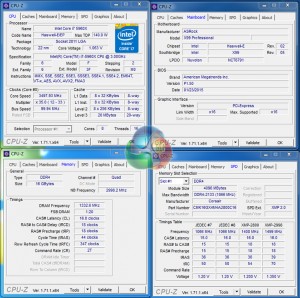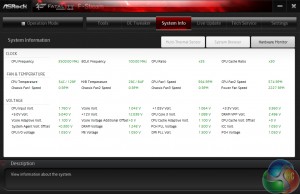We will be outlining the ASRock Fatal1ty X99 Professional motherboard's performance with the Core i7 5960X CPU at its stock frequency (3.5GHz due to forced turbo). Overclocked performance will be outlined later in the review.
The first thing to point out is that we were forced to use Corsair memory as opposed to our tests system's standard 2666MHz G.Skill Ripjaws4 F4-2666C15Q-16GRR set. We could not get the system to run stably with the G.Skill kit's XMP configuration (despite the kit being on the QVL), although this is an issue which ASRock knows about. Other memory vendors' parts seem to be unaffected.
Multi-core turbo (MCT) is not applied automatically when XMP is enabled on ASRock's motherboard. This is good for users who want Intel-standard Turbo Boost profiles, and bad for those who want the maximum speed without overclocking. We had to manually enable MCT, forcing our 5960X to a constant 3.5GHz operating frequency, in order to keep comparisons as fair as possible.
CPU-Z is unable to track the motherboard's voltages in real-time, so we rely upon ASRock's own monitoring tool for system voltage readings. We certified the tool by checking its consistency against direct multimeter readings from the onboard voltage measurement points. CPU Core Volt. reading seems the most reliable for CPU readings.
ASRock sneakily applies a higher-than-stock DRAM voltage of around 1.25V. This will not affect system stability, although it is what we would consider ‘cheeky‘. The stock-clocked CPU core voltage lingers around the 1.09V mark when loaded and drops substantially under low load.
X99 Motherboard Test System:
- Processor: Intel Core i7 5960X ES (3.5GHz all-core turbo).
- Memory: 16GB (4x 4GB) Corsair Vengeance LPX 2800MHz @ 2666MHz 16-18-18-44 DDR4 1.25V.
- Graphics Card: Asus R9 280X Matrix Platinum 3GB.
- System Drive: 500GB Samsung 840.
- CPU Cooler: Corsair H100i.
- Case: NZXT Phantom 630.
- Power Supply: Seasonic Platinum 1000W.
- Operating System: Windows 7 Professional with SP1 64-bit.
Compared X99 Motherboards:
- ASRock X99 OC Formula (BIOS v1.16) – with 16GB (4x4GB) Corsair Vengeance LPX 2800MHz 16-18-18-44 DDR4 @ 2666MHz 1.25V.
- ASRock X99 Extreme11 (BIOS v1.00) – with 16GB (4x4GB) G.Skill Ripjaws4 2666MHz 15-15-15-35 DDR4 @ 1.25V.
- Asus X99 Deluxe (BIOS 0801) – with 16GB (4x4GB) G.Skill Ripjaws4 3000MHz 15-15-15-35 DDR4 @ 1.35V.
- MSI X99S Gaming 7 (BIOS V17.3B1) – with 3.56GHz CPU and 16GB (4x 4GB) Corsair Vengeance LPX 2800MHz CL16 DDR4 @ 2800MHz 1.20V.
Memory support issues with earlier motherboard BIOSes means that there are still differences in the tests kits and configurations used. I had hoped that G.Skill's 2666MHz Ripjaws4 kit had stabilised our test system, but an incompatibility with ASRock's motherboard forced us back to Corsair's Vengeance LPX modules.
We had no problems using the Corsair kit at a 2666MHz set frequency. ASRock is aware of the issue with G.Skill sticks and told us that we aren't the first to comment on the instability problem. Other vendors' DIMMs seem to be problem-free.
Software:
- ASRock Fatal1ty X99 Professional BIOS v1.50 (latest).
- Catalyst 14.9 VGA drivers.
Tests:
- 3DMark 1.3.708 – Fire Strike (System)
- SiSoft Sandra 2014 SP2 – Processor arithmetic, memory bandwidth (System)
- Cinebench R15 – All-core CPU benchmark (CPU)
- WinRAR 5.10 – Built-in benchmark (CPU)
- HandBrake 0.9.9 – Convert 4.36GB 720P MKV to MP4 (CPU)
- ATTO – SATA 6Gbps, USB 3.0, M.2 transfer rates (Motherboard)
- RightMark Audio Analyzer – General audio performance test (Motherboard)
- Bioshock Infinite – 1920 x 1080, ultra quality (Gaming)
- Metro: Last Light – 1920 x 1080, high quality (Gaming)
- Tomb Raider – 1920 x 1080, ultimate quality (Gaming)
 KitGuru KitGuru.net – Tech News | Hardware News | Hardware Reviews | IOS | Mobile | Gaming | Graphics Cards
KitGuru KitGuru.net – Tech News | Hardware News | Hardware Reviews | IOS | Mobile | Gaming | Graphics Cards





Its quite controversial for a company linked to overworked employees suicides to name their product Fatality…
♪♪get $73 every /hr@ac23:
Going Here you
Can Find Out,
►►► http://CareerMaxJobs91.biz/live/trades/onlines…
You guys make some weird choices. You have trouble using the 2666MMhz g.skill memory and opted to use memory from Corsair, but later in the review you say that the 3000Mhz G.Skill memory was performing fine. So why not do the main tests with the 3000Mhz memory instead of 2666Mhz memory from another manufacturer. It seems to me that the 3000Mhz and 2666Mhz memory modules of G.Skill are closer to each other than 2666Mhz memory from different manufacturers..
so what’s better for gaming the z170 or the x99